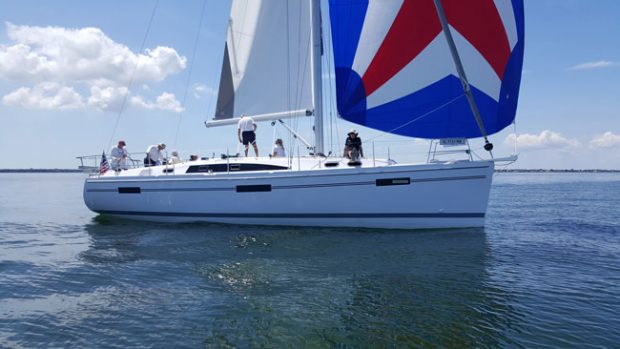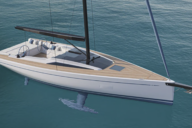Previously published in BWS by George Day
There is something about a tropical isle on the horizon that calls to me, as it does to just about every cruising sailor. The turquoise water of the shallows, the white sand beaches and the sway of palms all hold the promise of paradise. Although we weren’t technically in the tropics and we weren’t technically headed for a new landfall, we did indeed have two pretty islands ahead of us that gave us the afternoon’s goal: A circumnavigation.
The island in our sights was Egmont Key at the mouth of Florida’s Tampa Bay and just to the south of it lay Sandy Key that defined the channel we would take into the Gulf of Mexico. I was aboard hull number one of the brand new Catalina 425 with the proud owner, Russ Hoadley, and the boat’s designer and builder, Gerry Douglas. While Gerry and Russ are highly experienced offshore sailors and long term cruising boat owners, neither had had the time to sail around the world. So it was time for us boys to have a circumnavigation under our belts and Egmont would have to do.
We had left Regatta Point Marina just after 9:30 a.m. and motored in a building easterly breeze and under a clear sky down the Manatee River. The forecast for the day held the promise of fine weather in the morning with the prospect of thunderstorms increasing after 3 p.m. Plus, to the southwest of us over Hispaniola a tropical system called Invest 99L was dumping buckets of rain and trying to decide if it was going to turn into a hurricane. If it did, later that day we might be in its path. This was in the backs of our minds as we rolled out the mainsail and self-tacking jib.
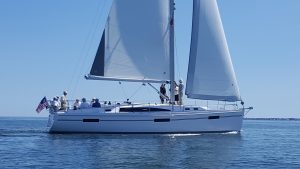
THE DESIGN
The new 425 is an evolutionary design for Gerry and Catalina. He had designed the original Catalina 42 many years ago and built over a thousand of them through several model updates. The 42 may be the most popular 42 foot cruising boat ever built. Now, with the new 425, Gerry was given the unique opportunity to have what he called a “do over.”
Two years ago Gerry brought out the all-new 275 sport boat that created a new design theme for the company. The boat had a nearly plumb stem, very long waterline, flattish sheer and a powerful rig with a sprit. The lines were modern, simple and fast and a lot of attention had been paid to moderate displacement and sailing performance.
The 425 is the first family cruising boat to adopt these design ideas and the result is a boat that has the Catalina family resemblance, but of the next generation. The 425 has the nearly plumb bow and very long waterline. It has a stainless steel fixed bow sprit that is a great platform for two anchors and the tacking point for downwind sails. The Selden rig has an in-mast furling mainsail that Doyle sailmakers gave a bit of positive roach and four vertical battens. The self-tacking headsail was cut with plenty of shape to add power but it is still dead simple to trim and tack. Sail tracks are mounted on the side decks so you can swap out the jib for a genoa up to about 150 percent of the foretriangle. Russ plans to race his 425 under PHRF so there was a lot of discussion during the day of what size and type of genoa and downwind sails would work best for him.
Catalina does a few things with the rig that are worth noting. The Selden mast is set up to have single lower shrouds in most cases but Catalina has opted to add a second forward lower to increase strength and ease rig tuning. The traveler is on the cabintop and out of the cockpit; the traveler control lines are rigged through six-part purchases and both lead to the port side cabintop winch—this is a small detail but shows the attention that has gone into the whole rig.
The cockpit is set up with twin Edson wheels on angled pedestals. The double-ended main sheet runs to the port sheet winch and the starboard cabintop winch. The jib sheet runs to the port sheet winch. Both helms have multi-function sailing instruments while the big Raymarine multifunction display or chartplotter is mounted in a swiveling pod on the aft end of the cockpit table module where it is out of the way but always visible.
The rig is great for a cruising couple and can be handled easily by one person while the autopilot steers. But it also flies enough working sail to make the boat a sprightly performer. In the eight knots of breeze, we sailed down the Manatee at five and a half knots on a broad reach. When you crunch the numbers, the 425 comes out with a sail area-to-displacement ratio of 21—that’s horsepower.
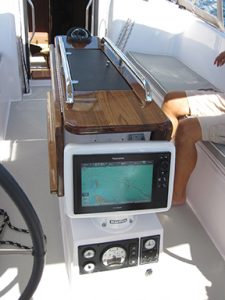
Under the water, Russ’ boat has the optional shoal draft wing keel—cast in lead and not iron—that gives the boat a draft of only four feet, 11 inches. The rudder is built with what Catalina calls its “Deep Defense” system that makes it nearly foolproof and very durable. The standard deep fin keel draws six, feet, eight inches.
As in the 275, a lot of attention has been given to reducing weight in the boat. The deck is cored with a carbon honeycomb that makes it incredibly stiff but also much lighter than a traditional Catalina deck. The hull is balsa cored above the waterline and solid below so the hull is both light and the panel structure very stiff. The displacement-to-length ratio of 130 puts the boat on the light side of the scale, which in turn means that it will be easily driven and fast. That’s certainly what we were finding.
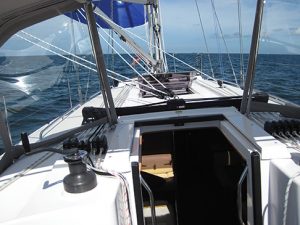
When we got to the end of the Manatee, we raised our tropic isle on the horizon and our voyage of the day was set. We fell off the breeze, rolled up the jib and hoisted the asymmetrical spinnaker—in its ATN spinnaker sock. The 425 reacted as one would hope by putting her shoulder down and charging at over seven knots toward the pass and the open sea.
LIVING ABOARD
For a lot of us, 42 feet is a sweet spot for a couple’s cruising boat. The size and weight of everything onboard is manageable; the strains on lines and sheets are not dangerous; and, the anchors are not too heavy for one person to lift. Yet, in 42 feet you can have a large and comfortable cockpit, a spacious saloon, three private cabins and two full heads.
The cockpit is the place where you spend most of your time on a cruising boat. On the 425, the seats are long and wide enough to lie down on and the starboard seat folds out to make a wide lounging space. The cockpit table on Russ’s boat is the optional teak version that is solid teak and starts life with 17 coats of high gloss varnish that glistens in the sunlight. The standard table is fiberglass. When the table is folded out, six people can dine comfortably. The table is mounted on a module that is integral to the deck and cockpit. The box itself has a small refrigerator in it for cool drinks.
The port seat has a huge hatch that opens to the port quarter cabin, which Gerry has designated as the “storage cabin.” The size of the hatch makes it simple to retrieve large sails, stow cushions or fenders and docking lines. It also is large enough to get the genset out of the boat without a Sawzall.
The canvas work on Russ’ boat will be the model for the standard factory canvas, except that Russ opted to make his six inches higher than normal to accommodate a tall crew member. Sitting anywhere in the cockpit you have a clear view forward and from both helm seats, which are slightly elevated, you can see the bow and headsail without obstruction.
The angle of the companionway ladder is low enough to enable a person to descend while holding a bag of groceries or a small child without having to turn around backwards. Once below, the U-shaped galley is to port and the aft head to starboard. Plus there is a vertical stainless steel pole to grab just as you step onto the cabin sole. Every boat should have one of these.
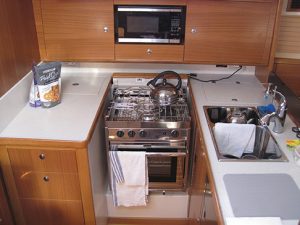
The galley has a large Isotherm front-loading fridge-freezer and a top-loading second fridge that can be dialed into a full time freezer. The twin sinks are nearly on the center line so they will drain on both tacks. The three burner stove and oven and the built in microwave will make cooking just like at home.
The quarter cabins have large double berths and plenty of storage for guest’s clothes. The port cabin is set up with a folding berth that creates a storage compartment outboard large enough for sails, lines and fenders. Access to the genset is through two opening doors.
The engine is under the companionway. The steps fold out of the way so you have good access to the front of the motor. You access the sides for oil changes through small side doors. The filters and cooling tank are neatly mounted in their own closet where you can easily access them for maintenance.
The dinette is U-shaped and will seat six for dinner. The table folds up to be a coffee table that can be lowered. Across are two seats with a table between them. The instrument, electrical and AC panels are in neat cabinets to starboard and very accessible. The vacuum battery switches are here as well, which makes them easily to use.
The forward, master cabin has a centerline double berth that has a kind of Lazy Boy tilt up feature that allows you to sit up in bed without a dozen extra pillows. The head is huge and has a separate shower that is closed off with three quarter height Plexiglass doors.
The wood used throughout the boat was teak with a maple ceiling inside the hulls. Catalina still uses teak veneered marine plywood for bulkheads and seals these to the pan liner, headliner and deck with epoxy paste. The corners of all drawers, cabinets and bulkheads—high wear areas— are solid finely fitted teak joinery. All doors are solid wood frames and fitted into door-frames that will not rack or swell. Almost no other production builders do it this way anymore.
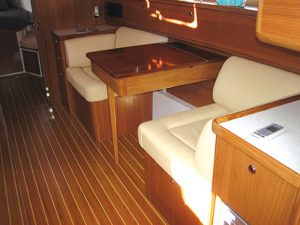
The 425 has a 13-foot, eight inch beam—moderate by modern standards but the interior has a spacious feel. The headroom throughout is six-foot six and all cabin cabinets are at waist level instead of shoulder height. This means you can see the hull’s full beam and see the light colored maple ceiling, which amplifies the sense of space and light. Overhead there are two large deck hatches, one opening forward and the other opening aft so that you can regulate the amount of breeze flowing through the boat.
The boat was built to have air conditioning and Gerry has contrived to have ducts at shoulder level under the deck, which pump the cool air into the boat from the top down just the way nature intended.
When we finished the day of sailing, we sat below with rain padding almost soundlessly on the cored deck and sampled a tot of Russ’s Guyanan rum. It was then I noticed the cut and contour of the dinette cushions with the low padded rail on the seat fronts and the neatly rounded backs that hit you just right on the lumbar—one of the most comfortable dinettes I have sat around in many years. Details like these really matter when you live aboard a boat for a while.
CIRCUMNAVIGATION
COMPLETE
We sailed briskly under main and spinnaker between Sandy and Egmont Keys and then shaped a course to the northwest to cross a series of sandbars on our way to the ship channel north of Egmont. The water was so clear you could see the bars so we eyeballed our way to deep water. We could carry the spinnaker efficiently to about 70 degrees of apparent wind.
We had to make some miles to windward to clear the north end of Egmont so we snuffed the spinnaker, dropped it and rolled out the jib again. This was very pleasant sailing in the bright sunlight of midday. But something was brewing to the east. By early afternoon, we had the spinnaker back up and were close reaching at seven or more knots back toward the Manatee River. Egmont with its turquoise water and white beaches was fading behind us and clouds were piling up and looking ominous ahead. Soon, we saw wind creases on the water and felt rain drops. We got the spinnaker down and packed away, fired up the engine and motorsailed the rest of the way up stream to the marina.
By now, rain squalls were coming through one after the next. Under the broad Bimini, dodger and zipped in insert we stayed mostly dry even though we were seeing gusts of 28 to 30 knots. We had a lucky lull as we backed the 425 into her slip and had her snugged down before the real rain arrived.
And so, the circumnavigation of Egmont was complete. Not a huge voyage but an excellent day of sailing on a beautiful bay on a day that gave us a taste of everything. And, it gave me a fine taste of what a great couple’s cruising boat Catalina has designed and built in the new 425.
CATALINA 425
LOA (w/sprit) 43’6”
LOH 41’8”
LWL 39’1”
Beam 13’8”
Draft 6’8”
Draft (shoal) 5’
Ballast 7,000 lbs.
Displ. 17,000 lbs
Sail area 914 sq. ft
Air draft 63’6”
Disp./LWL 130
Sail area/displ. 21
Ballast ratio 40%
Water 114 gals
Fuel 56 gals
Waste 54 gals
Engine 55 hp. Diesel
Catalina Yachts
7200 Bryan Dairy Rd.
Largo, FL 33777
727-544-6681
www.catalinayachts.com

